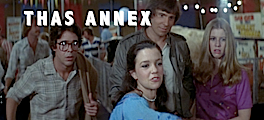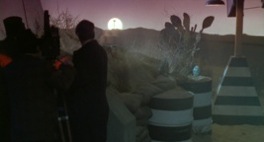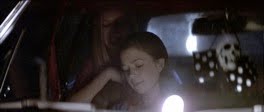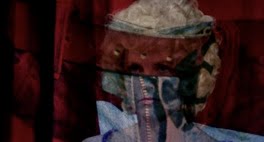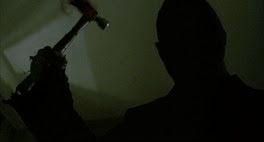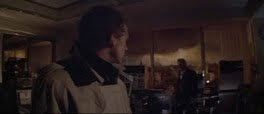Thanks to one Jonny Sambuca at the Tobe Hooper Fan Club Facebook page for finding and transcribing this quote:
"It was an unpleasant and totally impossible situation. There was a conspiracy where the first assistant director [Cardos], who was a friend, had shot a picture before for these people and actually had been promised this one. But Bill Devane wanted me, and so did the associate producer [Igo Kantor], and the actual producer [Edward L. Montoro], who produced Grizzly, The Day of the Animals, and had re-edited and distributed Beyond the Door." [Makes me wonder if Hooper was as avid a viewer of disposable genre fare as the ones he so knowledgeably calls by name here, even if the proposition was on the table to be working for these producers. I imagine these were somewhat high-profile pictures, as this was a different time when every low-budget genre film got its time in the drive-in or Broadway theater spotlight. So Hooper giving these films the time of day, as a movie-watcher, is less absurd than Michael Mann screening the Silent Night, Deadly Night remake for a taste of the current zeitgeist.]
"But this producer and I had a conflict that would occur daily. He had a vision, and I had a vision, and they clashed. I found myself not wanting to be a traffic cop... and consequently, I was not. So I shot about four days of the picture after prepping it. [ed. Emphasis mine] In four days, I probably had five major arguments." [What he entirely means by this "traffic cop" comment is a little hazy to me. If being a traffic cop implies following the directives of the producer, and so these directives essentially involved him "directing traffic" of actors, crew, etc. while the producer imposed his will, then the producer's directions may just have been either a total watering down of Hooper's trademark visual language or perhaps a total diverting of how Hooper saw and envisioned the characters and the story, and the producer was essentially trying to "direct" the film for him. Short of that, since Hooper says he and the producer had their arguments, meaning he wielded his directorial power to some extent in his four days, the producer was, we can presume, watching like a hawk, being critical, trying to rush his process.]
"The producer [Montoro] should have directed the movie. He did not confine his interests to story planning. He interrupted something that was very personal, very specific, very well thought-out, well-learned-through-hardship style. My vision of film is stylistic - which does not exclude commercialism. There's no reason why a commercial picture cannot also be a dynamite film. And the times we're in right now, it takes something to get those kids into the local theater. However, it's also a matter of having, once you get them in there, a degree of credibility." [It's rare to get a statement of intent from the notoriously inarticulate, unforthcoming Hooper, so it's a treat to get it in the form of an indirect statement regarding a project in which his mission was taken from him.] [Now, in this comment, the question is how closely he felt attached and how closely he developed a vision of The Dark, as suggested in his comment about "prepping it" and then going into production for four days. It may be very little. But as far as I see it, the film has a "credibility" that I do not think would be there had Hooper not been involved. In this comment, he mentions something that was "very personal," "very specific," and the question is if he is referring to The Dark specifically or if he is speaking generally. He seems to digress into something general, but there is no denying he must have been applying this "personal" and "specific" style to The Dark. So again, what exactly did he prep (at the least, it is certain locations they shot) and how does the extent of his preparations bleed into the film as it exists and was completed? To what extent can we surmise his involvement; to what extent did he think about the film, its script, and its cinematography, and how much influence could he have exerted before it was taken away from him? What survives of it? What survives, despite of and even in spirit with the film that was subsequently executed by the dutiful journeyman Cardos (whose distinctly amiable and gung-ho style I can appreciate), as aided by veteran cinematographer John A. Morrill, whose work, independently of a director, in such works as Kingdom of the Spiders and The Witchmaker, I find consistently incredible? Is director and cinematographer discussion during pre-production, if such a thing took place, enough to instill a certain level of constancy in a film's mood and style, even when the director is replaced? (I finally was able to listen to the voice of John Morrill in the commentary track of Kingdom of the Spiders, and it was a privilege to hear from his own mouth his feelings for and devotion to filmmaking. Unfortunately and sadly, I believe he passed away about a year ago. RIP.) As much as I can admire Cardos's flamboyant touch in his films, such as in the likes of 1984's Mutant, it is his work with Morrill that most suggests a true classical sophistication, as if Morrill was as sensitive to style as his directors, and was able to hone it. Morrill may very well be the "secret auteur" behind A Boy and His Dog, Kingdom of the Spiders, The Dark, The Hideous Sun Demon, and The Witchmaker.]
The story behind the production of The Dark is an unfortunate and secretive one, although probably less fodder for conspiracies than I may be want to believe. Eaten Alive, Poltergeist, Hooper's 2013 novel "Midnight Movie" - all works of Hooper's that, true to his character, are saddled with questions of authorship. Hooper proves a problematic auteur for many reasons, the sad fact that he has proven weak in the midst of conflagration and combativeness with many a studio and producer. This has extended to the anemic financial and creative means he'd find himself working with in his 2000s work and the government censorship that afflicted his last work Djinn. To add to this track record the possibly-jointly-composed The Dark is the straw breaking the camel's back. The Dark differs from Poltergeist, from Eaten Alive, which are undoubtedly his works, in that it is, undoubtedly, unquestionably, a work with two authors. Doubt lingers, but I have always maintained my admiration of the film, and evidence remains that Hooper's imprint is on the picture, if to a proportionally minor degree, evidence I will present later (in the post). Hooper himself states he only shot four days. Accounts vary, though, not because of some great, malefic design to obfuscate the truth, but because these things don't really matter to producers who are there merely to turn out a product and make a profit from it. If a film has two authors, one an irrepressible layman stylist, the other a deeply conceptual artist, then so what? As long as the film is finished and can be touted as a decent genre film by one director. The details are unimportant, the existence of a deep-seated artistry in the margins of their profitable sci-fi/horror tentpole film completely incidental and not worth studying or finding the truth. I speak mainly of Igo Kantor, who has mentioned, rather, two or three days that Hooper worked on it (Hooper, of course, may be the one who is mistaken), and who is less forthcoming about the reasons behind Hooper's ouster. In a recent commentary track on the Code Red Blu-Ray release, Kantor weaves an incredibly tangled story about Hooper sneaking off during lunch breaks, going to the nearby clinics to obtain medication for an undisclosed health condition, and his returning to set in a daze. The loyal and respectful Cardos, who is by all means a nice guy and a committed craftsman and maker of films, essentially murmurs assent of Kantor's account. Apart from that, and without mention of Edward Montoro's creative bulldozing, the agreed-upon stance on Hooper's firing is that, in those three days, Hooper fell a week short of schedule and he was formally let go. The medication stupors were merely an incident of note. Now there's no reason for these producers to need to show respect or courtesy to a man they worked only a few weeks with before severing ties with under less than amicable circumstances, but especially galling is the company line they tout in expressing, ostensibly respectfully, that Hooper was inevitably unfit for the job as he was only used to the independent productions and small crew he had while making Texas Chain Saw Massacre. The Dark would have surely been Hooper's cross-over into full-blown, high-budgeted, full-crew filmmaking, but they insist on a canned spiel about how Texas Chain Saw was filmed "over two years, off-and-on, on weekends," which is, of course, verifiably false. I, for one, see only weak justifications for an outfit that sees fit to only care about easy filmmaking and the profit margin, and would pull the same stunt of distrust and lack of good faith towards another experienced filmmaker, Mark Rosman, on 1984's Mutant.
Now the fact of the matter is, how much of the footage was shot by Hooper, that exists in the film, if any? This matter is, indeed, buried in contradictory statements and unforthcoming accounts. It is true that a majority of the film is likely entirely realized by John Cardos. There is no conspiracy to that effect. But there is a minor infidelity that seems to grow ever more tangible, a denial of a film's worth - its "credibility" - by a negation and disinterest in its likely fascinating, complicated, and infused-of-artistry development. I believe enough in this film that I have no doubt the pedigree of its many authors has lead to a beautiful, cleansing, if bastardized, rent, whiplashed, botched, film. I have already lauded cinematographer John Morrill, one of the authors. John Cardos brings vivacity of humor and a flamboyant camera to the proceedings, his mobile staging of populated scenes bringing effervescence to Morrill's precise refinement. And Stanford Whitmore's screenplay is something to behold, a matter-of-fact poetry to everyday trial surely brought in - into this so-called creature feature, with a truly lofty sense - from his long history as a television dramatist and published author of an anti-war novel (he also wrote the teleplay for the Poltergeist-inspiration Twilight Zone episode "Little Girl Lost" -- creeepy). But we may be being denied another author here, and this would be Hooper, who went into this project with the desire to lend credibility to a commercial endeavor. I think the film exudes his trial and his effort, even as it was inevitably lightened by Cardos's hand. I think Hooper set forth a mission that was inevitably realized, if marred by a producer who went laser-happy. I think the film's inconsistencies don't fly in the face of a cinematographer who has some standards of serious art-making, and I think Cardos's gauche quirky theatrics enhance a film that is all about its tapestry of characters, plus a monster that may as well be a MacGuffin, considering how totally and completely it is stripped of any rationale or explanation by money-hungry producers. I think Hooper saw a film of some dramatic higher purpose, a human ensemble picture similar to Salem's Lot and The Funhouse, and if he wasn't able to honor its coolness (he would have inevitably made it more dour, similar to Richard Fleischer grittying up John Farrow's noir confection in the notorious Howard Hughes cock-up His Kind Of Woman, creating an opposite effect than here, where the more whimsical Cardos came in and confectioned the work of a descendent of Fleischer), he was able to spearhead its poetic possibilities, such as a blind man who representationally appears before every murder, or the crossed connection when William Devane bumps into the doomed actor who essentially prances through the film like a lost lamb on the slaughter floor. Perhaps all of this was in the script by Stanford Whitmore, and Hooper and Cardos are merely the cogs, working at half-capacity, to simply getting this script to the screen so it can bring joy to the one person: myself. I think Hooper may still exist in the film, in the form of scenes he shot, and some evidence has presented itself. It might not be much footage, but it's something, and, as Hooper himself would say, a film is merely a spirit that must be channeled, invisible forces that get something unique and variously influenced onto the screen. No one owns a film. Hooper has only ever done his best to bring this forth to the people who can see.
Not too long ago, a credible public personage/established screenwriter who had collaborated with Hooper revealed, somewhat publicly, the following: Hooper at some point alluded to the fact that when he finally saw the film of The Dark, he "was shocked at how much he had shot ended up in the final version." Hooper would have "[disputed] getting director credit" (it's clear from the original account that Hooper means a director credit, not the director credit), by going to the DGA, but
since he didn't do it upon the film's release, the ship had undeniably sailed.
Now for a person who shot only four days but was probably under the apprehension that all his footage would be scrapped, seeing any amount of your footage on the screen would probably come as a shock. This story does not necessarily press quantity, but merely, you can say, the principle of the thing. The idea of Hooper's work remaining in the film has experienced its own turgid arc. John Cardos, in a first commentary recorded for the Shriek Show DVD, states that none of Hooper's footage was used in the final film because the DGA would not allow it. But in the recent Blu Ray release by Code Red, in which a brand new commentary was released featuring Cardos as well as Igo Kantor, when asked the question by moderators, Kantor relents, stating uncertainly that maybe some of Hooper's little footage is in the film, "mostly not." The preponderance of evidence thus points to Hooper's footage being in the film. What to do with this possibility, then, is my own personal dilemma.
We can always question Hooper's meaning in his claim in a number of ways. Perhaps he was being facetious. Perhaps he was merely being bitter about the amount of work he did cultivating the film, and seeing it represented up there but by a different filmmaker's hand riled him to the point of making a specious claim about getting an ironic sort of credit. Perhaps he confused his footage for an identical reshoot, and does that even happen? (Besides in Justice League and All the Money in the World and... I mean, films not made by cheapskate 70's production companies.)
So now it is simply upon me to make some completely unsupported value judgements about the film, and my theorizing of what Hooper may have shot. This is going to be simply presented and to-the-point. I have to think educatedly about a film's production schedule, about the pages per day of a normal shoot, about location access and whether things would be shot consecutively/on the same day/etc. I do not know too much about these things, so bear with me:
* Igo Kantor, in the Blu Ray commentary, mentions a shooting schedule no more than a month. Can this support an idea that Hooper, if shooting four days, may have shot 1/4 (to 1/5) of the picture? John Cardos mentions spending a few days in the Fontana, CA winery where they shot the climax of the picture. If that one sequence took two to three days, that even more favors more of a wealth of Hooper footage than if the film took 5 to 6 weeks to film.
* Now to get to what I think may have been Hooper-shot scenes. I am going to have to suggest all scenes with Jacquelyn Hyde. Why? Even though I may very well be wrong, John Cardos does not have one word to say about Jacquelyn Hyde in any of his printed interviews or DVD/Blu-Ray featurettes. He mentions Keenan Wynn, Cathy Lee Crosby, Richard Jaeckel, Biff Elliot, even the actor who plays the blind man, but he never says anything more than "Yeah, her" when Hyde is mentioned. Not exactly incontrovertible evidence, especially since he was present during Hooper's days as well and thus would have been on the set with her, but this is an easy "in" for the De Renzy scenes, which exhibit a visually baroque and studied quality not present in even the most visually disarming, but essentially boilerplate, scenes that I may have entertained the idea as belonging to Hooper. Hooper has a restrained touch, whereas Cardos has a "glam" touch. Thus, some of my
favorite moments are inevitably going to be Cardos-shot, as The Dark is a film in which I love each moment almost more than the last (except for the climax, which is
sturdily shot enough but essentially lame and full of Cardos's trademark over-the-top stunt work). There is a BTS shot of Cardos
directing Cathy Lee Crosby and Keenan Wynn in the little cafe they have a
lunch at, and that scene always gets me, from its initial dolly shot to
the two actors' muggy performances (definitely a Cardos trademark),
shot in a beautiful Panavision OTS (thank you, John Morrill). The car chases, which I love, are no doubt Cardos, who has a flair for such things, as a former stunt man and stunt driver (plus they're not going to be shot in the first four days of shooting).
The De Renzy scenes, though, are marked by very unusual camera work. These scenes would be, and that I would venture to be Hooper-shot: De Renzy's home scenes, her visit to the police station, possibly the yacht scene, though I cannot imagine Hooper going the whole nine yards and filming on a yacht with a full crew, then getting fired a day or so later.
* The 90% Sure: Assuming any of Hooper's footage is in the film, we can be sure of:- Roy Warner (William Devane) gets the news about his daughter's murder at a payphone. This was reportedly the scene during which the producers made the decision Hooper was just not working fast enough. (But it's only a 30-second scene consisting of two shots from the same angle!)
* The 80% Sure: The most idiosyncratically Hooper-reminiscent scenes. These contain camera movements or framings I tend to think no one else can duplicate:
- De Renzy's interior house scenes. There are 4 separate, if brief, scenes inside her home. 1) De Renzy smokes and shuts off sports news. 2) De Renzy walks to the mirror and grasps her throat. 3) De Renzy shuts off sports news yet again, walks to mirror, is beset by vision of the monster and a supernatural windstorm. 4) Roy Warner visits the upturned home and finds a stroke-addled De Renzy in her bedroom. Would it be logical to assume 1-3 were shot on the same day? The lighting scheme never changes between them. The only doubt would be the filming of the special effects sequence in 3, the winds ransacking the house, and also the question of whether 4 is shot in a completely different location than 1-3. Are 1-3 a sound stage? 4 has some particularly Hooperian images, but it might be a location (an actual Beverly Hills home that they dressed to look wrecked) they must have used up most of a single day on. I would put more of my bets on 1-3 as Hooper filmed than 4.
1) 

4)

- Roy Warner confronts Officer Mooney (Richard Jaekel) in the street outside the police station. When Mooney gets out of his car, there is a swiveling camera along with him and this shot is in numerous Hooper works! It's gotta be! Plus, the use of the architecture of the body of the Corvette to frame the actors.
- I'm always struck by the cold, cold fear that Hooper did not work at all with Cathy Lee Crosby. She's much too posh and buoyant for the low-key Hooper, who'd only worked with relative unknowns (then again, he did work with Mary Travers of "Peter, Paul, and", then later worked a few days with Oliver Reed, Sterling Haydn, Klaus Kinski, and Susan George). But an initial shot in the broadcast room scene of the monitor banks that then glides over to Keenan Wynn, Crosby, and Jay Lawrence is the sort of awkward panning shot that occurs in so many Hooper films.
* The 70% Sure
- Mooney and Bressler's (Biff Elliot) office scenes. These are two scenes, one involving De Renzy visiting them and the other involving a meeting with their Police Captain (Warren Kemmerling) and the police pathologist (Casey Kesem). The latter is another risky proposition, positing Hooper worked with the one and only Casey Kesem. Both scenes are populated with idiosyncratic and very particular camera movements and framing. Perhaps they were filmed in conjunction, and perhaps the exterior scene between Devane and Jaeckel was filmed outside this location on the same day, for expediency's sake.* The 50% Sure: As you can see, the probability has jumped down by a larger margin, as I am beginning to push the boundaries of my 4 day limit.
- Another police station scene, a department meeting to discuss the murders with the police pathologist, with less of the instantly placeable Hooperian tics, more a generic competency. But my strategy is to place all common-location scenes in a tier. If one scene greatly resembles Hooper in a location, then the probability of another scene shot in the same or similar location being filmed by Hooper is higher.
- The morgue/hospital scene and the bar scene. I am really pushing it now with these two completely separate scenes shot in two different locations, but they represent a continuity in the creation of Devane's character and they really speak to me of Hooper's style. Kantor and Cardos claim Devane was the most upset with Hooper leaving the project, and that Devane and Hooper essentially came up with the characterization together of Roy Warner as an ex-Easy Rider sort of hippie. I can only imagine it was Hooper who could have given him such off-the-wall directions as, in the bar scene with Jaeckel, "Keep on coughing for some reason, you're either terminally ill or sick, i.e. it represents your soul!"

* Scenes That I Really Want Hooper to Have Shot, But Probably Didn't
- Scenes in the hallways of the news station. There are two of these scenes: Cathy Lee Crosby, Keenan Wynn, and Jay Lawrence discussing Crosby's copy. The second, Cathy Lee Crosby nervously navigating the station hallways and enduring a dread-induced elevator ride, before running into Roy Warner and going home with him. Hooper loves his dread-filled elevator sequences, but it seems plausible for such a sequence to be pulled off by anyone.

- Keenan Wynn fleeing from an unknown/not-present fear in the parking garage of the news station. This scene is integral to the film's thematic holism, but it can just as well have been executed by anybody.

- Two elegant scenes involving William Devane. One, in which he takes a call in his home from his ex-wife's lawyer and that culminates in a slow track-in into a picture of his murdered daughter as a little girl. The other, Devane ordering a burger at a drive-thru fast food place that culminates in an indescribably beautiful dolly-boom pull-out.

- Devane and Crosby first meet in a swanky restaurant (Devane bumps into Randy on the way in)
- The romance scenes between Devane and Crosby at Devane's character's home/Devane and Crosby plan out their investigation in Devane's character's home
- William Devane questions Vivian Blaine about De Renzy on her Courtney Sea Four yacht (Yacht, daytime)
* What we have left to possibly determine is scenes that were definitely shot by Cardos, aka show no special sign of Hooper.
- All murder sequences (no principle actors) and Murder Aftermath sequences (Principal police characters) (I love the "Murder Aftermath" scenes, which punctuate the film like a refrain and are pointedly shot, so these should belong in the "Wish Hooper Shot" section; these are paired with the murder sequences below in subnumerals):
1) The opening death of Warner's daughter (Santa Monica location) (Night)
2) The ice factory manager's death (Factory location) (Night)
2a) Mooney and Bressler question the gang youths (Factory location) (Night)
3) The burly vigilante citizen's death (Santa Monica location) (Night)
3a) Mooney, Bressler, and Police Captain Speer at the crime scene (Day)
4) The airline attendant's death (Burbank Airport location) (Night)
4a) Mooney, Bressler, and Speer oversee clean-up of the Airport crime scene (Night)
- Bar scene accompanying/preceding the burly vigilante's death sequence
- The gay protest scene outside the police station (Cathy Lee Crosby, Keenan Wynn, Richard Jaeckel, Biff Elliot)
- All connective driving scenes/"car mount" scenes (Crosby & Lawrence, Jaeckel & Elliot, mainly; I love these scenes, more "Wish Hooper Shot" fodder. ;_; I love Hooper car-mount scenes...)
- Bar-hopping montage of Devane and Crosby searching for the young actor (Two separate bars)
- Devane and Crosby find the young actor Randy (Jeffrey Reese) by running into his girlfriend at a bar. Randy looks for his keys in the grass outside the bar and drives away drunk. (Bar #3)
- Nighttime car chase sequence (All principles, minus Keenan Wynn)
- The climax at the abandoned winery (Winery location) (All principle actors, minus Keenan Wynn)
I think I will have to accept that Cardos did indeed shoot 3/4ths of this picture, and so, inevitably, some of my most wished-for scenes for attributing to Hooper will not be the case. Still, the question of what 4 days out of 20-25 days means still stands, and the verity of Hooper's claim that some of his footage is in there is a meaningful one, as it would make him a part of this movie and what is, to me, its anomalous existence as a work of deep, human, comic, and textural exquisiteness, mixed in with the visible tragedy of the forced commingling of high art and low. Yet I cannot see Cardos directing the blind man to enter so abstractly into the scenes of the picture, a plot element he hardly seems to understand, if the Blu Ray commentary track is anything to go by. I can't imagine him understanding the meaning behind the final close-up shot of a blind man's walking stick tapping down an urban sidewalk like a substituting of the monster, whose feet stalking victims was given the same treatment. I suppose I can imagine him directing it, though, and perhaps it was just all in the script. I imagine Cardos following the script like a bible, which I must thank him for. But, again, what exactly was this "prep" Hooper spoke of, besides location scouting and planning out the shooting schedule? Perhaps it was a concerted belief in the multi-facets of this screenplay. Perhaps it was discussions with William Devane, maybe other actors, about what it would mean for them to play these characters. I don't see Hooper waxing eloquently about the depths of his characters and stories to actors prior to shooting, but I can at least see him giving out the energy of someone who wants to make a damn good and damn meaningful film out of what is essentially a piece of monster nonsense. His merely bringing together cast, crew, and cinematographer might have set this ship sailing in the right direction, at least relatively speaking, even as it would turn out mutinous.
I can only imagine what the film would be like if the monster remained an abused mutant boy and not a space alien. It wouldn't exactly explain the strange occult reasons for his murder-a-night, victim-beheading modus operandi, perhaps some sort of psychological, Freudian removal of the face. In the novelization (which I have read), the monster is a pirate ghost whose grave Warner tracks down in an attempt to vanquish his curse (if my memory serves me correctly). Perhaps Hooper's contribution was to remove the ghost element. But, like I said, the monster remains, for me, simply a device for the elements of greater interest.
So the anatomy of The Dark is something we must attribute to two, or three, or four creators. Its soul remains the script, its body Cardos and Hooper, its blood running through its veins John Morrill. Forever I will be grateful to all four of them, though, as it stands now, one of those authors' contributions remains cloaked in mystery and negation. I will always be on the lookout for that missing limb, that phantom appendage, and the god (Hooper) that got away with divesting his bastard child, this illegitimate progeny, this Frankenstein monster self-mockingly begotten, laughing and singing sweetly its own existence, bringing something beautiful into this world without anyone - its predominant director, its producer, its actors - even noticing. Perhaps Whitmore, Morrill, and Hooper did.












































